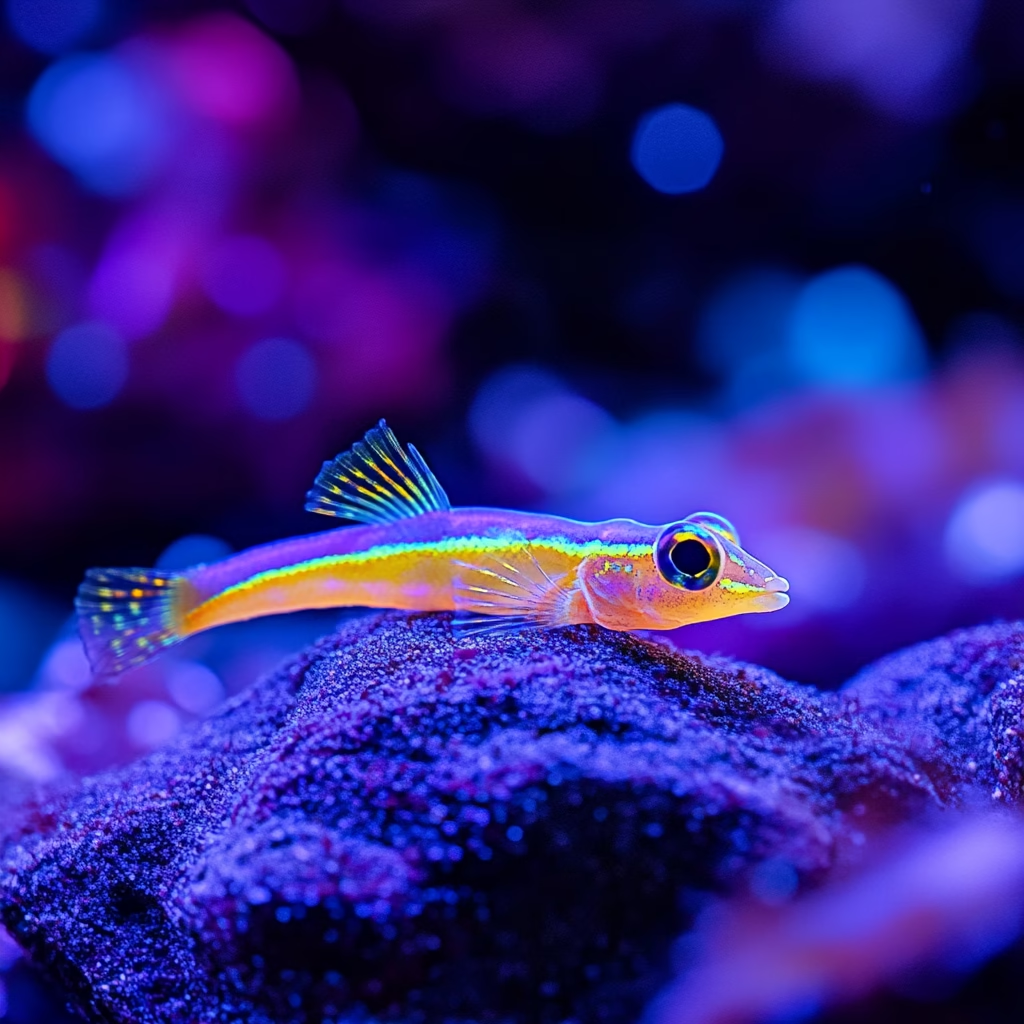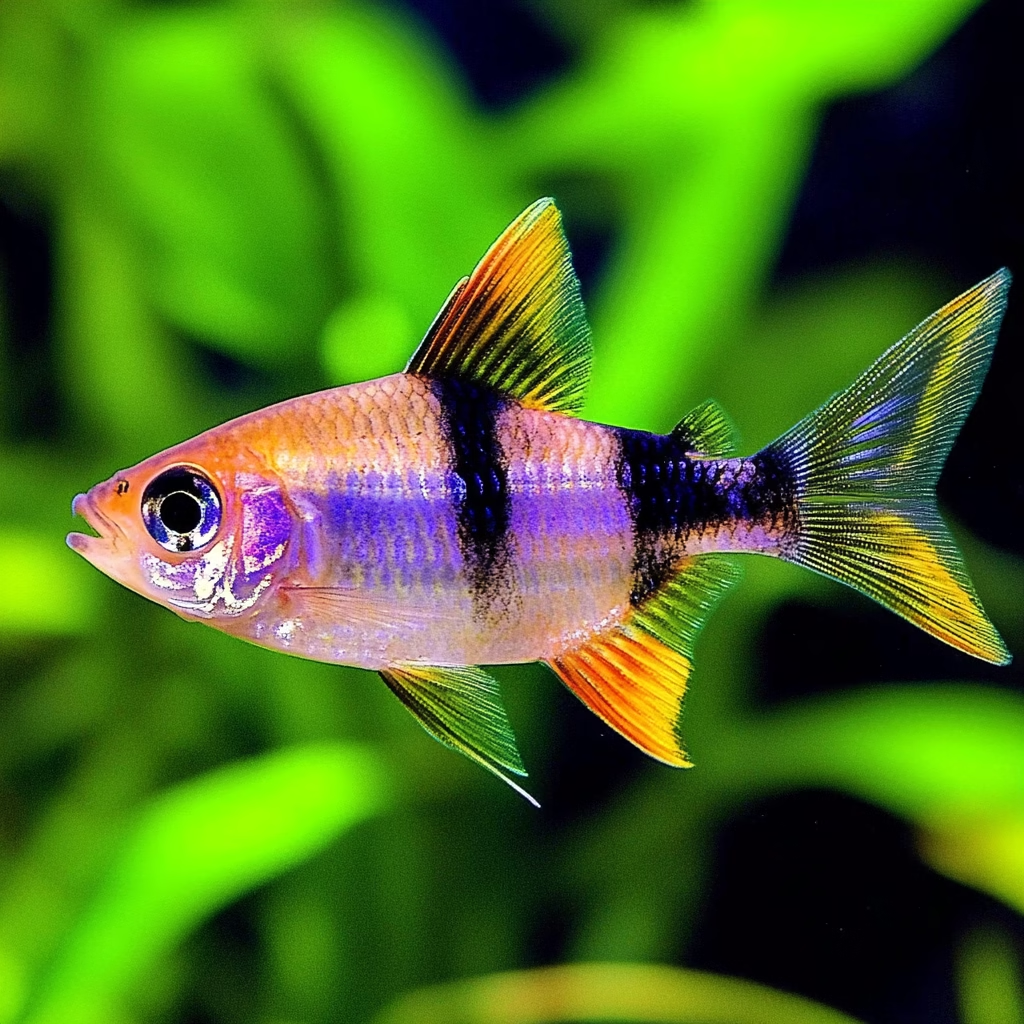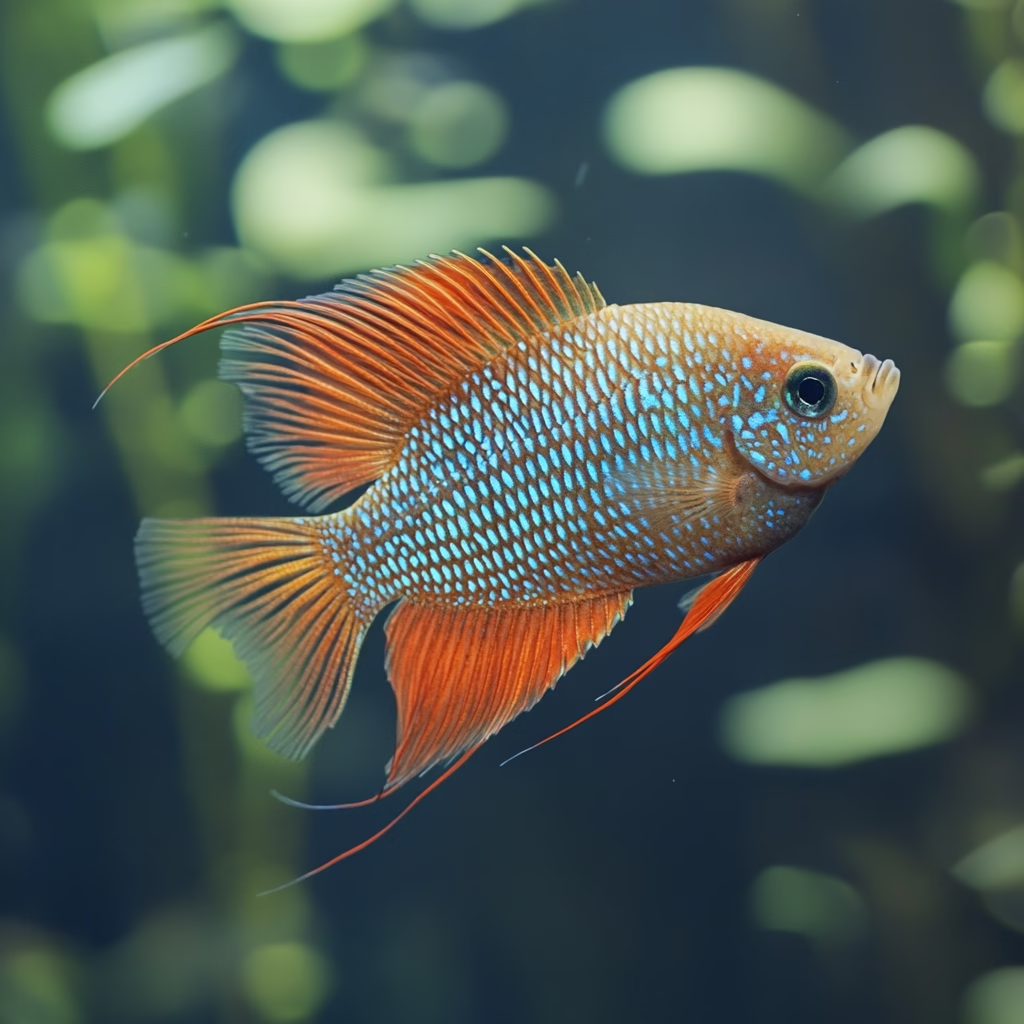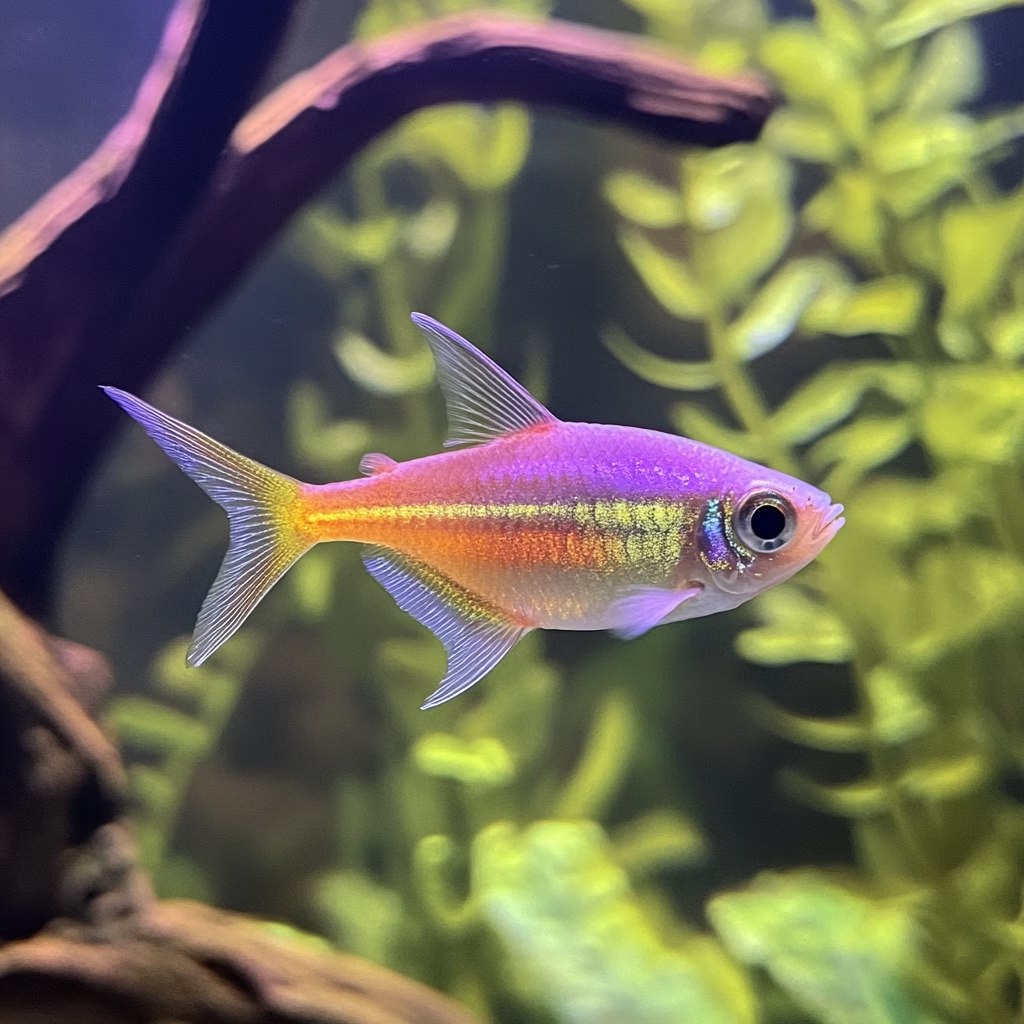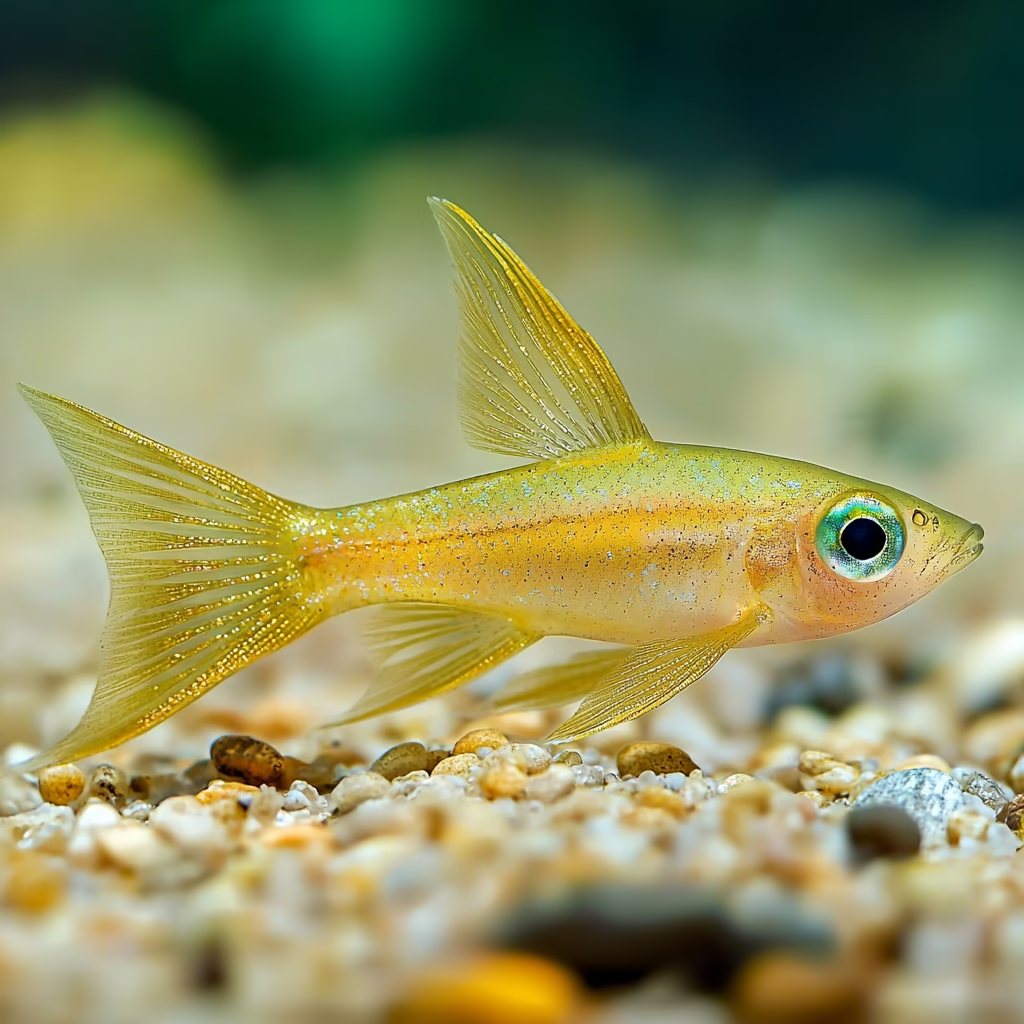The neon goby (Elacatinus oceanops), with its striking electric blue stripe set against a black body, is one of the ocean’s most recognizable small fish. Native to the coral reefs of the Caribbean Sea and western Atlantic Ocean, these diminutive creatures rarely exceed 2 inches in length but play a disproportionately important role in reef ecosystems. Their reputation as “cleaner fish” has made them not only ecologically significant but also highly sought after in the marine aquarium trade.
What makes the neon goby truly fascinating is its symbiotic relationship with larger fish species. These tiny cleaners set up “cleaning stations” on the reef where larger fish even potential predators visit to have parasites, dead skin, and other debris removed from their bodies. This mutually beneficial relationship is a perfect example of nature’s intricate balance and one of the many reasons these small fish have captivated the attention of marine biologists, aquarists, and ocean enthusiasts worldwide.
Neon Goby Identification and Physical Characteristics
Appearance and Coloration
The neon goby’s most distinctive feature is the vibrant, electric blue stripe that runs horizontally along each side of its body. This brilliant blue coloration contrasts sharply against its predominantly black body, creating a visual signal that’s instantly recognizable to both humans and marine life. The intensity of this blue stripe serves as an advertisement to larger fish, signaling the goby’s cleaning services.
Adult neon gobies typically measure between 1-2 inches (2.5-5 cm) in length, making them one of the smaller fish species on the reef. Their elongated body shape is complemented by a rounded head and relatively large, alert eyes that help them spot parasites on their clients. Their mouths are positioned in a slightly downward angle, perfectly adapted for picking parasites from their host fish.
Distinguishing Features from Similar Species
The neon goby belongs to the Elacatinus genus, which includes several similar-looking “cleaner goby” species. While many feature the characteristic blue stripe, the neon goby’s stripe is particularly vibrant and tends to have a more neon-like quality than its relatives. Some closely related species include:
- The sharknose goby (Elacatinus evelynae), which has a somewhat thinner blue stripe
- The yellownose goby (Elacatinus randalli), which displays yellow coloration on its snout
- The broadstripe goby (Elacatinus prochilos), which has a wider blue stripe
For accurate identification, observers should note the width and intensity of the blue stripe, the overall body shape, and the specific geographic location where the fish is found.
Habitat and Distribution of the Neon Goby
Natural Range and Preferred Environments
Neon gobies are native to the western Atlantic Ocean, with their range extending throughout the Caribbean Sea, the Gulf of Mexico, and the coastal waters of Florida and the Bahamas. They are particularly abundant in the Florida Keys, Belize, and various Caribbean islands.
These small fish thrive in clear, warm waters around coral reefs, particularly in areas with moderate to strong currents. They show a preference for:
- Shallow reef environments (typically 10-70 feet deep)
- Areas with abundant coral heads or rocky outcroppings
- Locations with good water clarity
- Sections of reef with healthy fish populations that can serve as clients
Microhabitat Selection
Within the broader reef environment, neon gobies are selective about their specific microhabitats. They typically establish their cleaning stations on prominent coral heads or rock formations that are easily visible to passing fish in need of cleaning services. These stations become well-known locations on the reef, with client fish regularly returning to the same gobies for cleaning.
Interestingly, research has shown that neon gobies are territorial about their cleaning stations, with mated pairs defending prime locations from other gobies. The quality of a cleaning station’s location directly impacts the number of clients a goby can attract, which in turn affects its feeding success and overall fitness.
The Neon Goby’s Ecological Role
Cleaning Symbiosis Explained
The neon goby’s most significant ecological contribution comes from its role as a cleaner fish. This symbiotic relationship, known as cleaning symbiosis, represents one of nature’s most fascinating examples of mutualism, where both participants benefit from the interaction.
When a client fish approaches a cleaning station, it often adopts a characteristic pose—holding still with fins spread and sometimes mouth open—signaling its intent to be cleaned. The neon goby then meticulously inspects the client’s body, gills, and even mouth, removing:
- External parasites (particularly isopods and copepods)
- Dead or damaged tissue
- Excess mucus
- Fungal or bacterial infections
- Small growths or lesions
This cleaning service provides the goby with a reliable food source while offering the client fish improved health and reduced parasite loads. Research has demonstrated that fish that regularly visit cleaning stations show better overall health metrics than those that don’t have access to cleaners.
Impact on Reef Fish Health
The ecological impact of neon gobies extends beyond individual client fish to affect the health of entire reef fish populations. By removing parasites and treating minor infections before they can develop into more serious problems, neon gobies help maintain the overall health of the reef ecosystem.
Studies have shown that reefs with healthy cleaner fish populations tend to support greater fish diversity and abundance. When cleaner fish are experimentally removed from reef sections, researchers observe:
- Increased parasite loads on remaining fish
- Higher incidence of skin infections
- Decreased fish diversity over time
- Changes in fish behavior and movement patterns
This evidence underscores the neon goby’s status as a “keystone species”—one whose impact on the ecosystem is disproportionately large compared to its abundance or size.
Neon Goby Behavior and Life Cycle
Social Structure and Mating Habits
Neon gobies typically live in monogamous pairs that jointly defend their cleaning station territory. These pairs form strong bonds that can last for extended periods, working together to service client fish and defend against intruders.
The mating process begins with elaborate courtship displays where males perform a distinctive swimming pattern to attract females. Once paired, the gobies prepare a nesting site, typically in a small cave or crevice near their cleaning station. The female lays adhesive eggs on the ceiling of this protected space, which the male then fertilizes.
What makes neon goby reproduction particularly interesting is the shared parental care. Both parents take turns guarding and maintaining the egg clutch, which typically contains 50-100 eggs. They fan the eggs with their fins to ensure proper oxygenation and remove any debris that might foster fungal growth.
Development from Eggs to Adults
The neon goby’s eggs hatch after approximately 7-8 days of development. The newly hatched larvae are initially planktonic, drifting with ocean currents for about 3 weeks. During this vulnerable period, mortality rates are high, with only a small percentage surviving to reach the juvenile stage.
Those that survive eventually settle on the reef and begin to develop their adult coloration and behavior. Young neon gobies often form small groups before eventually pairing off and establishing their own cleaning stations. They reach sexual maturity quickly, often being able to reproduce within 4-6 months of hatching.
The total lifespan of a neon goby in the wild is typically 1-2 years, though they can live slightly longer in captivity under optimal conditions. This relatively short life cycle, combined with their specialized ecological role, makes them an interesting subject for studies on adaptation and specialized niche development.
Neon Gobies in the Aquarium Trade
Popularity Among Hobbyists
The neon goby has become one of the most popular marine aquarium fish for several compelling reasons:
- Their striking coloration makes them visually appealing
- Their small size allows them to thrive in modestly sized aquariums
- They’re generally peaceful and compatible with many other fish species
- They provide the practical benefit of cleaning parasites from other tank inhabitants
- They’re relatively hardy compared to many other marine species
- They can be captive-bred, offering a more sustainable choice for environmentally conscious hobbyists
These attributes have firmly established the neon goby as a staple in the marine aquarium hobby, particularly for reef tank enthusiasts.
Captive Breeding Success
One of the most positive developments in neon goby conservation has been the success of captive breeding programs. Unlike many marine species that remain challenging to breed in captivity, neon gobies have proven relatively straightforward to propagate in controlled environments.
Commercial breeding operations now produce thousands of captive-bred neon gobies annually, significantly reducing pressure on wild populations. These captive-bred specimens offer several advantages over wild-caught individuals:
- They’re often hardier and better adapted to aquarium conditions
- They typically arrive free of parasites and diseases common in wild specimens
- They’re more likely to accept prepared foods rather than requiring live foods
- Their purchase doesn’t impact wild reef ecosystems
For aquarium keepers interested in neon gobies, seeking out captive-bred specimens represents both an ethical choice and a practical one, as these fish generally show better long-term survival rates in home aquariums.
Conservation Status and Threats
Current Population Trends
The neon goby is not currently listed as endangered or threatened by major conservation organizations. Their relatively wide distribution throughout the Caribbean region, combined with their high reproductive rate and successful captive breeding programs, has helped maintain stable populations in many areas.
However, localized population declines have been observed in regions experiencing significant reef degradation. The species’ specialized ecological niche makes it particularly vulnerable to changes in reef health and fish community structure.
Threats to Wild Populations
While not facing immediate extinction risk, neon gobies do face several challenges in the wild:
- Habitat Degradation: Coral reef decline due to ocean acidification, warming waters, pollution, and physical damage threatens the neon goby’s habitat.
- Collection Pressure: Despite captive breeding success, collection for the aquarium trade continues in some areas, potentially impacting local populations.
- Disruption of Client Relationships: Declining populations of larger reef fish that serve as cleaning clients can indirectly affect neon goby survival.
- Invasive Species: In some areas, invasive lionfish and other non-native predators have increased predation pressure on small reef fish like gobies.
Conservation efforts focused on broader reef protection, sustainable collection practices, and continued development of captive breeding programs represent the most effective approaches to ensuring the neon goby’s long-term survival.
Research and Scientific Significance
Studies on Cleaning Behavior
The neon goby has been the subject of numerous scientific studies investigating the mechanics and evolution of cleaning symbiosis. Researchers have examined questions such as:
- How do cleaners and clients recognize each other and communicate intent?
- What mechanisms prevent predatory fish from eating their cleaners?
- How do cleaners identify and target parasites on client fish?
- What are the physiological and behavioral adaptations that facilitate cleaning?
These studies have yielded fascinating insights into the complex communication systems that exist between different fish species and the evolutionary pathways that led to these specialized relationships.
Evolution of Mutualistic Relationships
Evolutionary biologists find the neon goby particularly interesting as a model for studying the development of mutualistic relationships. The cleaning symbiosis exhibited by these fish represents a remarkable example of how species can evolve interdependent relationships that benefit both parties.
Research suggests that the distinctive blue stripe evolved specifically as a visual signal to advertise cleaning services, allowing potential client fish to quickly identify neon gobies as cleaners rather than prey or competitors. This type of signaling adaptation demonstrates how natural selection can favor traits that facilitate mutualistic interactions between species.
Conclusion: The Neon Goby’s Enduring Appeal
The neon goby, despite its diminutive size, exemplifies nature’s remarkable ability to develop specialized roles within complex ecosystems. From their distinctive appearance evolved specifically to signal their cleaning services, to their bold behavior that allows them to safely interact with fish hundreds of times their size, these small reef dwellers represent a fascinating evolutionary success story.
For marine aquarium enthusiasts, the neon goby offers a rare combination of striking beauty, interesting behavior, and practical benefits through their cleaning activities. Their successful captive breeding further makes them an environmentally responsible choice for conscientious hobbyists.
As coral reefs face mounting threats from climate change, pollution, and overfishing, the neon goby serves as a reminder of the intricate relationships that make these ecosystems so remarkable—and so worthy of our protection efforts. By understanding and appreciating species like the neon goby, we gain greater insight into the complex web of interactions that sustain marine biodiversity.

